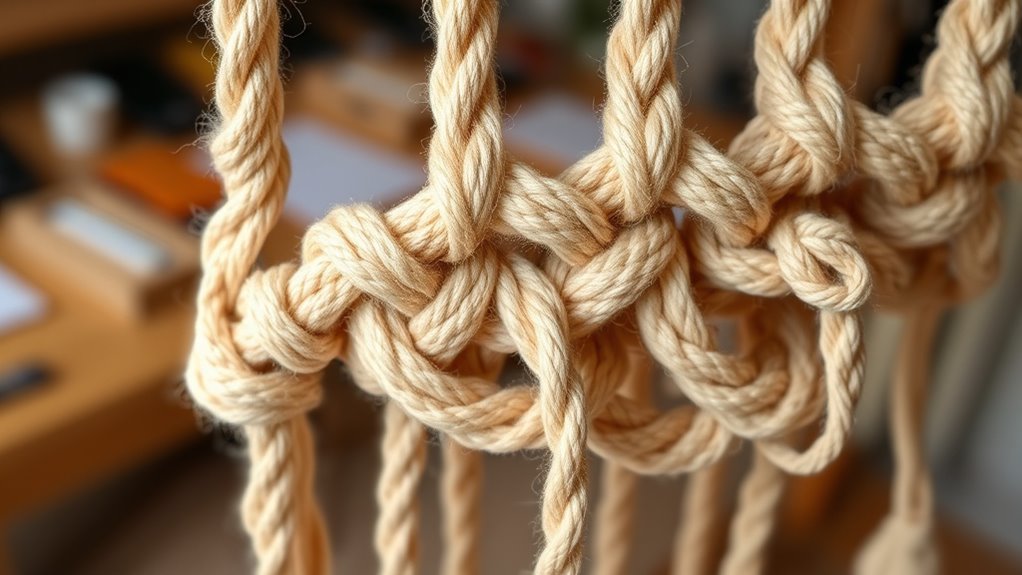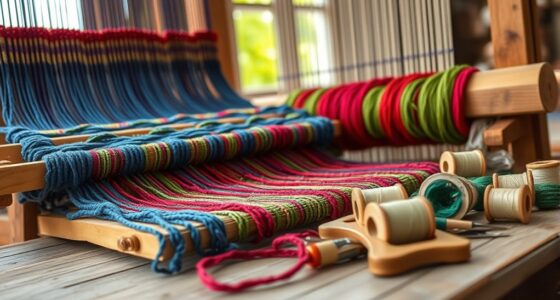To get started with macramé, you’ll want to learn key knots like the square knot for texture, the lark’s head for attaching cords, and the double half hitch for decorative patterns. Practice maintaining even tension and selecting quality cords to improve your work. Preparing your materials and workspace will also help make the process smoother. Keep practicing these basics, and you’ll see your skills grow—there’s more to discover as you go along.
Key Takeaways
- Master essential knots like square, lark’s head, and double half hitch to build diverse patterns and decorative elements.
- Maintain even tension and use flexible cords for consistent, neat knots and smooth designs.
- Prepare materials by selecting quality cords, organizing them, and securing workpieces for efficiency.
- Start with simple projects using soft cords and measuring materials to build foundational skills.
- Practice knotting techniques regularly, secure knots firmly, and trim excess cords for a professional finish.
Essential Macramé Knots to Know
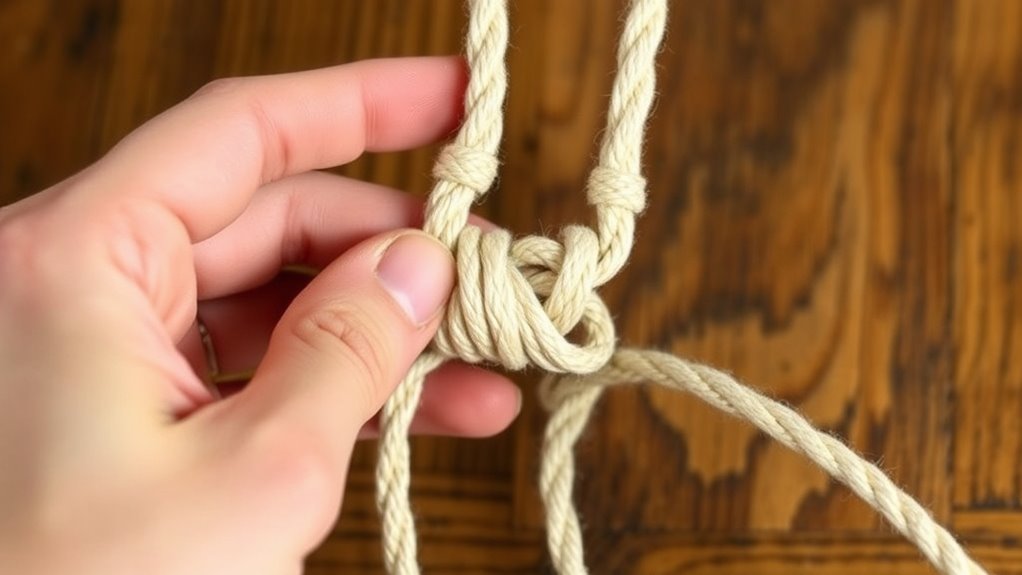
To create beautiful and sturdy macramé projects, you need to master some essential knots. These knots are the foundation for adding fringe creation and decorative accents that enhance your designs. The square knot is versatile and perfect for creating textured patterns and borders. The lark’s head knot is great for attaching cords to your base, giving a clean, professional look. The double half hitch knot allows you to build intricate, geometric designs that can serve as decorative accents. By mastering these knots, you can craft projects that are both visually appealing and durable. Incorporate these techniques into your work, and your macramé creations will stand out with well-defined fringes and charming decorative details.
Basic Techniques for Knot Tying
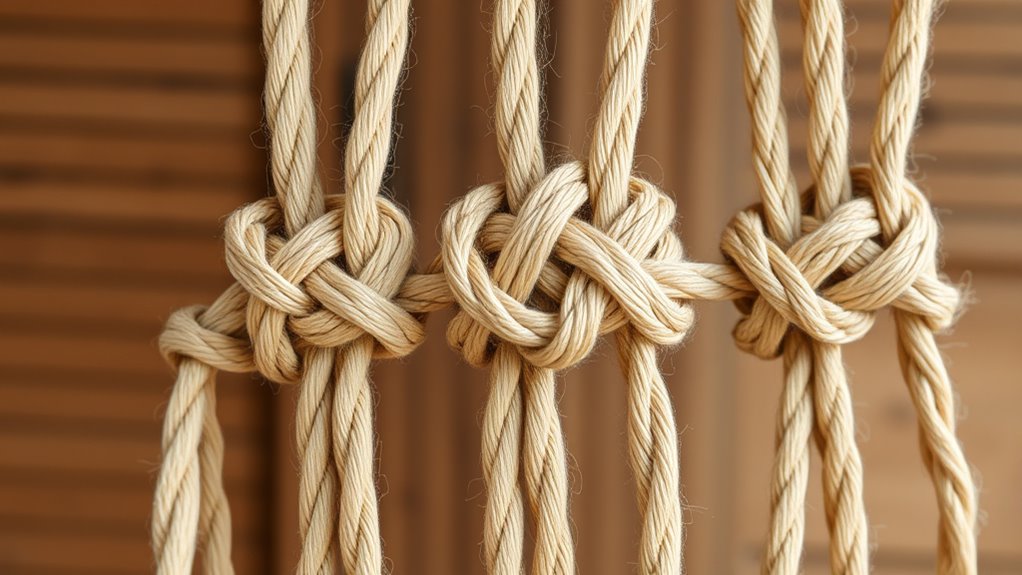
Mastering the basic techniques for knot tying is the foundation of creating strong and attractive macramé projects. Your knot tension affects both appearance and durability, so keep it consistent. When selecting cords, consider material, thickness, and flexibility to suit your design. Proper tension ensures even knots and a professional finish. Practice makes perfect—tighten knots just enough for stability without over-compressing the cords. Use the following tips to refine your skills:
| Tip | Why It Matters | Result |
|---|---|---|
| Maintain even tension | Prevents uneven patterns | Smooth, balanced design |
| Choose flexible cords | Easier to manipulate | Precise, neat knots |
| Use appropriate cord thickness | Suits your project | Better knot control |
| Practice knot consistency | Improves overall look | Uniform, attractive finish |
| Keep cords untangled | Saves time and effort | Cleaner work |
Additionally, understanding knot tension can greatly improve your overall craftsmanship. Perfecting these techniques boosts confidence and elevates your macramé craft.
How to Prepare Your Materials
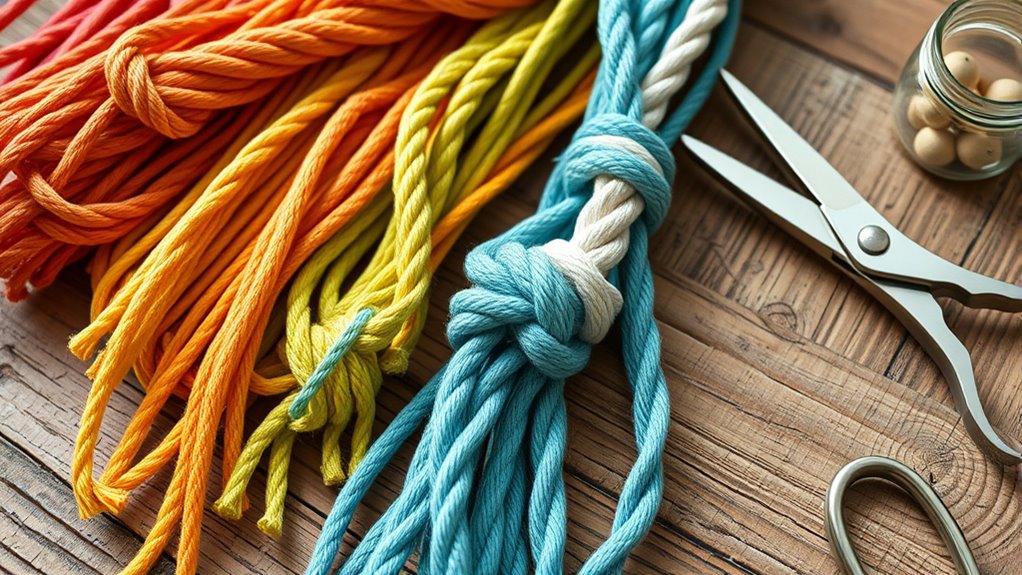
Before you start knotting, it’s essential to prepare your materials properly. Good material selection guarantees your project turns out just as you envision. Choose high-quality cords suited for your design and consider color and texture. Setting up your workspace comfortably and efficiently helps maintain focus and prevents tangles. Here are some tips:
- Clear a flat, well-lit surface
- Gather all necessary tools and materials
- Organize cords by length and color
- Use clips or tapes to secure cords temporarily
- Keep scissors and measuring tape nearby
Proper material selection and workspace setup make the process smoother and more enjoyable. Taking these steps upfront saves you time and frustration, allowing you to focus on mastering your knots and techniques with confidence.
Starting Your First Macramé Project

Ready to bring your macramé ideas to life? The first step is choosing the right project that matches your skill level and interests. Start simple with a small wall hanging or plant hanger to build confidence. Next, selecting the perfect materials is essential. Opt for soft, manageable cords like cotton or jute, which are easy to knot and hold well. Measure and cut your cords to the recommended lengths for your project. Gather a sturdy dowel or ring as your base. Keep your workspace organized, so you can focus on your knots without distraction. By choosing the right project and selecting the perfect materials, you’ll set a solid foundation for a successful first macramé creation. Enjoy the process and let your creativity flow.
Tips for Perfecting Your Knots
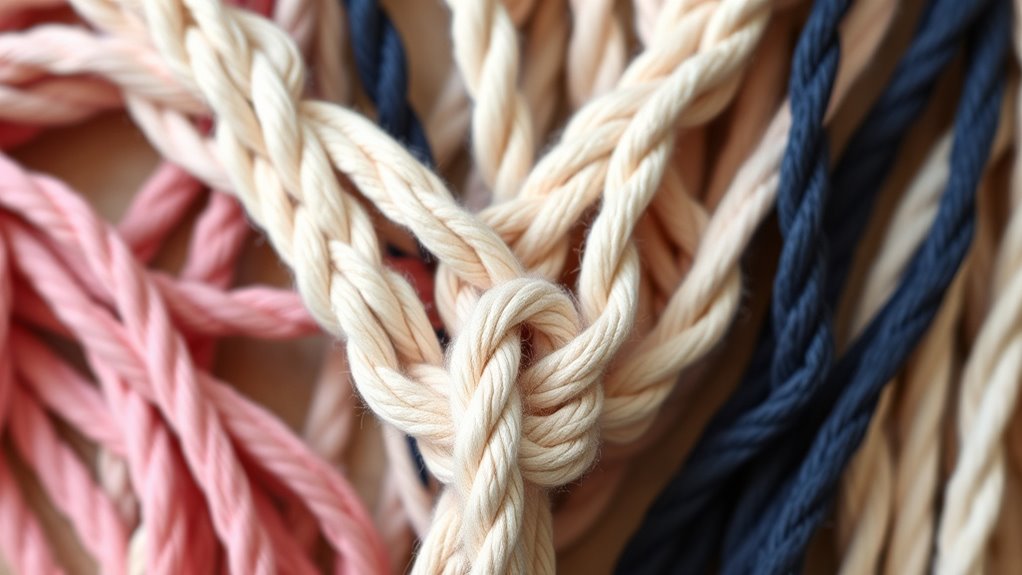
Getting your knots just right can make all the difference in the final look of your project. To achieve this, focus on consistent knot tension—neither too tight nor too loose—as it guarantees a uniform pattern. Practice subtle adjustments as you work, maintaining steady tension throughout. When finishing, pay attention to the finishing touches, securing knots firmly and trimming excess cord neatly. Regularly checking your work for consistent hours helps ensure your project stays on schedule and aligns with typical store hours. To improve your knot quality:
Achieve a polished look with consistent tension and careful finishing in your knot work.
- Maintain even tension during each knot
- Use your fingers or tools to tighten knots gradually
- Keep cords straight and aligned before tightening
- Regularly check your work for consistency
- Finish with a secure knot and tidy trims
Mastering knot tension and thoughtful finishing touches will elevate your macramé work, giving it a professional and polished appearance.
Frequently Asked Questions
What Are Common Mistakes Beginners Make in Macramé?
One common mistake you make as a beginner is tangling knots, which can happen when you’re not paying attention or pulling too tightly. You also often have uneven tension, making your projects look inconsistent. To avoid these issues, keep your knots neat and consistent, and work slowly to maintain even tension. Practice regularly, and you’ll find it easier to create clean, professional-looking macramé pieces.
How Do I Choose the Right Cord for My Project?
When choosing the right cord for your project, consider the cord material and project durability. Opt for cotton or jute for lightweight, decorative pieces, while nylon or polyester work better for outdoor or heavy-duty projects. Think about how sturdy you want your finished piece to be and select a cord that matches that need. This guarantees your project holds up well and looks great, making your macramé experience more enjoyable.
Can Macramé Be Done With Synthetic Fibers?
Yes, you can definitely use synthetic fibers for macramé. They’re popular because of their durability, resistance to moisture, and vibrant color options. Synthetic fibers like nylon or polyester hold knots well and last longer, making your project more resilient. Plus, they’re easy to clean and maintain. So, if you want a sturdy, weather-resistant piece, synthetic fibers are a great choice for your macramé project.
How Do I Fix Mistakes in My Knots?
Mistakes in macramé can be remedied by carefully correcting knots. To undo errors, gently loosen or unwind the problematic knot, avoiding damage to your work. If a knot is tight, use a small tool or needle to help release it without pulling on the entire piece. Patience prevents frustration, and practicing undoing knots builds confidence, ensuring you can correct mistakes smoothly and seamlessly, saving your project from setbacks.
What Are Some Creative Project Ideas for Beginners?
You can create simple plant hangers or wall decor to start. Use basic knots like the square knot for a stylish plant hanger or a chevron pattern for wall art. Keep your projects small and manageable, experimenting with different cord colors and textures. These beginner-friendly ideas help you practice your knots while making beautiful, functional pieces for your home, boosting your confidence as you learn new techniques.
Conclusion
Now that you know the essential knots and techniques, you’re ready to create stunning macramé pieces. Remember, practice makes perfect—don’t get discouraged if your knots aren’t flawless at first. Did you know that macramé has seen a 60% surge in popularity over the past two years? This shows how crafting with your hands can be both relaxing and trendy. Keep experimenting, and soon you’ll craft beautiful, personalized decor that truly reflects your style.

